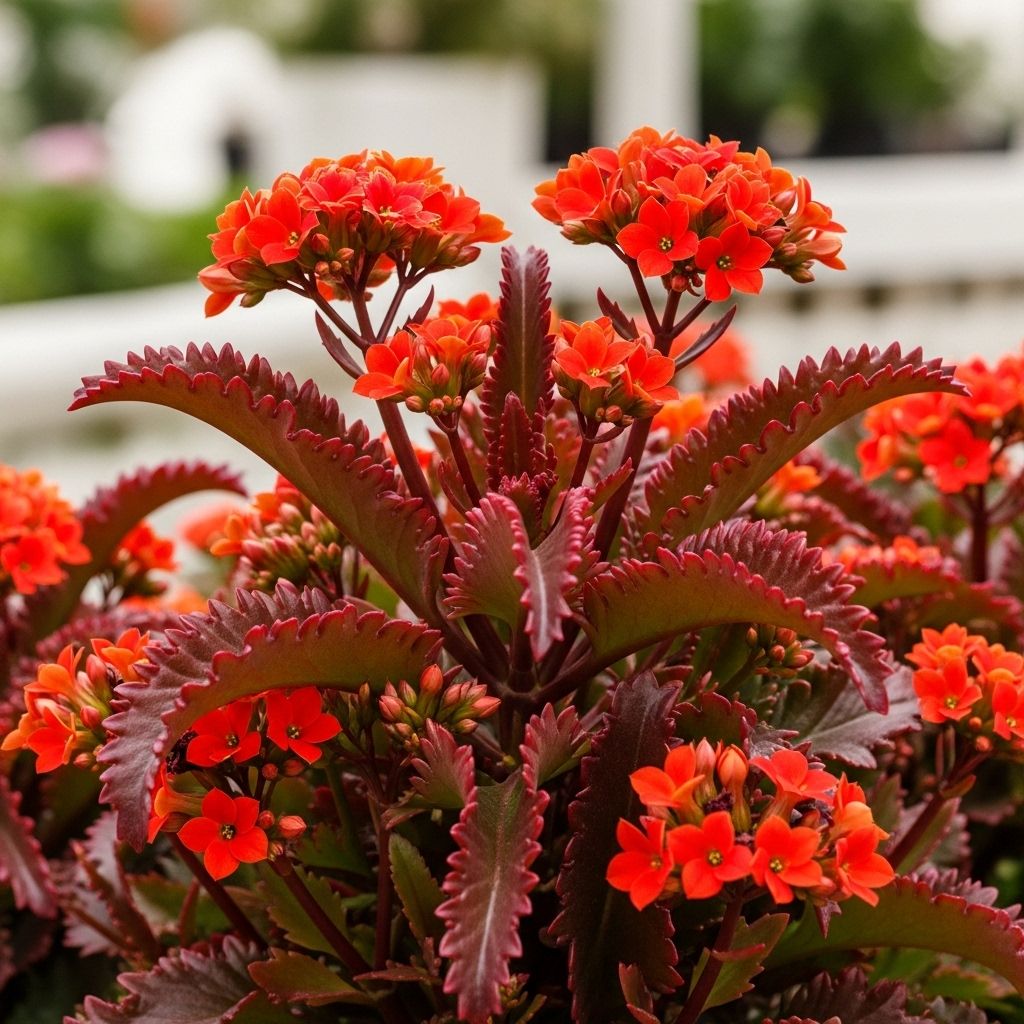Dragonfire Kalanchoe Care: Essential Guide To Planting & Growth
Unlock the beauty of Kalanchoe 'Dragonfire' with expert tips for vibrant growth, propagation, and thriving succulent care indoors or outdoors.

Image: HearthJunction Design Team
Kalanchoe ‘Dragonfire’: Planting, Growing, and Care Guide
Kalanchoe ‘Dragonfire’ is a dazzling cultivar known for its apple-green and fiery red foliage, as well as its quick and clumping growth. Whether you’re a novice succulent lover or an experienced collector, this guide covers everything you need to know—from origins and appearance to care, propagation, and troubleshooting—to help your Dragonfire thrive.
About Kalanchoe ‘Dragonfire’
Kalanchoe ‘Dragonfire’ is a relatively new and reliable succulent cultivar. Bred in California in 2015 by cross-pollinating Kalanchoe luciae with an unidentified hybrid species, this plant boasts striking colors and easy growth habits. Over the years, it has become increasingly popular for its sturdy nature and eye-catching foliage, making it a favorite in both indoor and outdoor collections.
- Common Name: Kalanchoe ‘Dragonfire’
- Botanical Lineage: Hybrid (K. luciae × unnamed hybrid)
- Origin: California, bred in 2015
- Family: Crassulaceae
- Type: Perennial, succulent
- Native Region: Descendant of Madagascan species
Distinctive Features and Appearance
Kalanchoe ‘Dragonfire’ stands out for its bold leaf coloration and compact, clumping growth. The plant forms a loose rosette that typically reaches 4–6 inches in height but quickly spreads due to its high offset production.
- Leaf Color: Apple-green centers that turn bright red at the margins. The intensity of the red increases with greater sunlight or cooler temperatures.
- Growth Habit: Mounding and clumping, with new offsets appearing early in the plant’s life.
- Flowers: Rarely blooms; the rosette form is so attractive that flowers aren’t missed.
Tip: If you provide ample sun, especially during winter or cooler weather, you’ll see the most dramatic colors.
Comparing Dragonfire to Other Kalanchoe Varieties
| Variety | Leaf Color | Growth Habit | Height | Sunlight |
|---|---|---|---|---|
| Dragonfire | Green center, red edges | Loose rosette, clumping | 4″–6″ | Full-partial sun |
| K. luciae | Green/red, wider leaves | Rosette, less clumping | Up to 12″ | Full sun |
| Donkey Ears (K. gastonis-bonnieri) | Bright green, spotted | Large, arched leaves | Up to 20″ | Full-partial sun |
Growing Kalanchoe ‘Dragonfire’
Kalanchoe ‘Dragonfire’ is among the easiest succulents to grow, making it a top choice for beginners and busy gardeners alike. With the right environment and care, it will quickly fill a pot or garden bed with a riot of color.
Optimal Conditions for Growth
- Light: Prefers full sun to partial shade. More sun brings out richer red coloring in the leaves.
- Soil: Must be well-draining; a cactus/succulent mix or sandy loam works best.
- Watering: Allow soil to dry between waterings. Overwatering is the most common cause of problems.
- Temperature: Thrives in USDA Zones 9–12. Protect from frost; can be grown as a container plant in colder regions.
- Humidity: Tolerates dry air; does not require high humidity.
Planting Instructions
- Choose a container with drainage holes or a garden spot that doesn’t retain water.
- Fill with a gritty, well-draining soil mix (commercial cactus mix is ideal).
- Plant ‘Dragonfire’ at the same depth as its nursery pot.
- Water lightly after planting, then allow the soil to dry completely before watering again.
Note: Dragonfire quickly produces offsets, which can crowd the pot. Thin out as needed to maintain aesthetics and plant health.
Care Requirements for Kalanchoe ‘Dragonfire’
Watering
Dragonfire, like most succulents, prefers to dry out between waterings. Water every 1–2 weeks during the growing season (spring–summer) and less in winter. Always check the top inch of soil—if it’s dry, it’s time to water.
Light
Bright, indirect light is ideal indoors, but outdoor plants flourish in full sun to light shade. More sunlight encourages deeper red colors but protect the plant from intense midday rays if growing in hot locales to prevent sunburn.
Soil
A lightweight, fast-draining mix is essential. You can amend regular potting soil with sand, perlite, or pumice if a specialty mix isn’t available.
Temperature & Humidity
- Optimal temperature: 60°–85°F (15°–29°C)
- Bring indoors if frost is expected; Dragonfire is not frost-hardy.
- Dry air is fine—no special humidity needs.
Fertilizing
Feed lightly in spring and summer with a diluted, balanced fertilizer formulated for cacti or succulents. Too much fertilizer can lead to leggy growth and pale leaves.
Pruning
- Trim off any leggy or damaged stems with clean scissors.
- Remove offsets to control spread and replant as desired.
Propagation of Kalanchoe ‘Dragonfire’
Kalanchoe ‘Dragonfire’ is famously easy to propagate. The plant produces offsets—baby plantlets—around the base that can simply be separated and repotted. Propagation is also possible via stem cuttings.
How to Propagate by Offsets
- Wait until the baby plants are large enough to handle (2–3 inches tall).
- Gently remove the offset from the mother plant, making sure to keep some roots attached.
- Allow the offset to dry for a day to heal the cut end.
- Plant in dry, well-draining soil and water sparingly until established.
How to Propagate by Stem Cuttings
- Select a healthy, mature stem and cut just below a leaf node with a clean, sharp knife or scissors.
- Let the cutting dry for 1–2 days to callous over.
- Place the cutting in moist, well-draining soil.
- Keep out of direct sun until new roots develop, then transplant as needed.
Potting and Repotting Tips
- Repot when the plant becomes root-bound or when offsets crowd the pot.
- Choose a slightly larger container, refresh the soil, and repeat the initial planting instructions.
- Repot in spring for minimal stress and best results.
Common Problems & Solutions
| Problem | Symptoms | Solution |
|---|---|---|
| Overwatering | Yellow, mushy leaves; root rot | Let soil dry, remove affected parts, repot if necessary |
| Underwatering | Wrinkled, shriveled leaves | Increase watering frequency, ensure adequate moisture |
| Sunburn | Brown leaf spots, crispy leaf margins | Move out of intense midday sun or provide shade |
| Pests (mealybugs, aphids) | White residue, sticky leaves, stunted growth | Treat with insecticidal soap or neem oil; increase airflow |
| Leggy Growth | Long, stretched stems; pale leaves | Increase light exposure, prune back, fertilize sparingly |
Design Ideas and Container Combinations
- Mass in colorful succulent bowls or dish gardens for a dramatic effect.
- Mix with sedums, echeverias, or haworthias for textural contrast.
- Grow alone in minimalist white pots to highlight foliage color.
- Use in succulent wreaths or living walls for year-round interest.
Frequently Asked Questions (FAQs)
Q: Is Kalanchoe ‘Dragonfire’ toxic to pets?
A: Yes, like most kalanchoes, ‘Dragonfire’ can be toxic if ingested by cats, dogs, or other pets. Keep plants out of reach of curious animals.
Q: Why are my Dragonfire’s leaves turning pale?
A: Pale or faded leaves are usually a sign of too little sunlight. Move your plant to a brighter spot, but avoid sudden exposure to full, direct sun.
Q: Can I grow Kalanchoe ‘Dragonfire’ outdoors?
A: Yes, but only in frost-free climates (USDA Zones 9–12). In colder areas, grow Dragonfire in containers so you can bring it indoors for winter.
Q: Does Kalanchoe ‘Dragonfire’ flower?
A: This variety rarely blooms, but its attractive rosette form and leaf coloration make up for the lack of flowers.
Q: How do I encourage more vivid red coloration?
A: Provide as much sunlight as possible and expose the plant to cooler temperatures (above freezing) to intensify red leaf edges.
Summary: Why Grow Kalanchoe ‘Dragonfire’?
Kalanchoe ‘Dragonfire’ is a standout among succulents for its vibrant, two-tone leaves and low-maintenance care. Its ability to quickly offset and fill containers, tolerate some neglect, and provide dramatic color makes it a star for beginner and expert gardeners alike. Whether indoors on a sunny windowsill or outdoors in a well-drained bed, this variety promises year-round beauty with minimal fuss.
Grow Kalanchoe ‘Dragonfire’ for a touch of fire and foliage magic in your succulent collection!
References
Read full bio of Shinta












